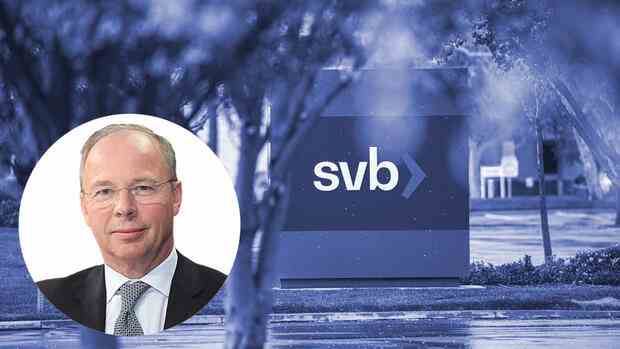Michael Heise is chief economist at wealth manager HQ Trust.
Typically, in banking crises, the facts are looked at first, which could speak for a limited problem. The SVB was not subject to particularly strict scrutiny, as is the case for larger systemic banks, and it had a particular clientele from the start-up scene, which had to reduce their deposits quite significantly in recent times. From this point of view, the development could be seen as a not unexpected collateral damage of the rapid rate hikes that have taken place.
The problem with predicting banking crises, however, is that in addition to complex relationships, psychology and trust play a very important role and are difficult to predict. Households and companies holding unsecured investments with banks will question how safe they are.
As we have seen with the systemically important Credit Suisse, this does not only happen in relation to medium-sized American institutions. If there are any doubts, deposits are shifted, for example from regional banks to larger banks, which are monitored more intensively and are under what is assumed to be a state protective umbrella (too big to fail). Or they are invested in short-dated securities, money market funds or cash.
SVB guaranteed customers security of deposits
Whether such processes take place, which could cause difficulties for the entire banking system, depends on the credibility of the commitments made by central banks and deposit protection funds. In the case of the SVB, customers were guaranteed the security of their deposits. However, if more and more banks were to be affected by deposit withdrawals, the security funds, which are financed by the banks themselves, would no longer be sufficient to ensure complete protection.
In the end it is only the commitment of the governments, i.e. the taxpayers, that can prevent a negative spiral of deposit withdrawals and liquidity bottlenecks in the banking system. The promise made by former Chancellor Merkel and then Finance Minister Steinbrück during the financial crisis in 2008 that all deposits are safe is the most prominent example of such a state rescue commitment.
>> Read here: Star investor Warren Buffett intervenes after SVB bankruptcy
Does it have to come to that this time too? Something speaks against it. There is a market corrective in the form of falling interest rates and interest rate expectations. After the collapse of the SVB and the collapse of the Credit Suisse share price, yields on government bonds have fallen, so the valuations of these securities have risen. This reduces losses when banks sell government bonds to create additional liquidity.
In addition, potential liquidity commitments by central banks are particularly important, as was the case with Credit Suisse and the US Federal Reserve, with the latter even accepting government bonds at par as collateral for credit lines.
Through these programs, the still very high central bank reserves of the commercial banks – in the European Monetary Union they are around four trillion euros, in the USA three trillion US dollars – can be expanded if necessary. This should remove the basis of a negative anxiety psychology. However, central bank loans to commercial banks also increase the risk for taxpayers. And the central banks’ plan to reduce their bloated balance sheets is likely to be shelved for the time being.
>> Read here: Will the turnaround in interest rates plunge the world into a new financial crisis?
What lessons should investors learn from the crisis? Once again it is evident that banking crises also come as a surprise to central banks and rating agencies. The interest rate hikes by the central banks, which initially gave the banks’ share prices a tailwind, have become a problem for some institutions such as the SVB, which do not have their interest rate risks properly under control.
Even if the central banks announce countermeasures, the phase of uncertainty about the stability of the financial system is likely to continue. Investors will position themselves cautiously as government and central bank programs will fail to protect shareholders and bondholders.
Some may bet that the central banks will fundamentally correct their restrictive anti-inflationary policy and hold out the prospect of interest rate cuts in the near future. This bet is not recommended because central banks will not question the credibility of their promise of stability. If this were also doubted, the next crises would be programmed.
The author:
Michael Heise is Chief Economist at HQ Trust.
More: How it came to the deep fall of Credit Suisse
